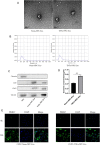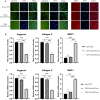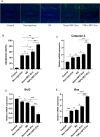Degenerative Nucleus Pulposus Cells Derived Exosomes Promoted Cartilage Endplate Cells Apoptosis and Aggravated Intervertebral Disc Degeneration
- PMID: 35359595
- PMCID: PMC8963919
- DOI: 10.3389/fmolb.2022.835976
Degenerative Nucleus Pulposus Cells Derived Exosomes Promoted Cartilage Endplate Cells Apoptosis and Aggravated Intervertebral Disc Degeneration
Abstract
Intervertebral disc (IVD) degeneration is a complex multifactorial disease model, which pathogenesis has not been fully defined. There are few studies on the information interaction between nucleus pulposus (NP) cells and cartilage endplate (CEP) cells. Exosomes, as a carrier of information communication between cells, have become a research hotspot recently. The purpose of this study was to explore whether degenerative NP cells-derived exosomes promoted CEP cells apoptosis and aggravated IVD degeneration. The degenerative NP cells model was induced by TNFα. NPC exosomes were isolated from the supernatant of the NP cell culture medium. The viability of NP cells and CEP cells was examined by CCK-8 assays. The exosomes were identified by TEM, NTA, and western blot. Extracellular matrix (ECM) metabolism was measured by cellular immunofluorescence and qRT-PCR. Apoptosis was detected by flow cytometry and TUNEL. X-ray and magnetic resonance imaging (MRI), as well as hematoxylin-eosin (H&E), Safranine O-Green staining was adopted to evaluate IVD degeneration grades. TNFα had a minor impact on NPC viability but inhibited ECM synthesis and promoted ECM degradation. TNFα-NPC-Exo had less effect on CEPC proliferation but promoted CEPC apoptosis and affect ECM metabolism, inhibiting aggrecan and collagen II expression and enhancing MMP-3 expression. TNFα-NPC-Exo aggravates IVD degeneration in a rat model and promoted CEPC apoptosis. In conclusion, this study demonstrated that degenerated NPC-exosome could induce apoptosis of CEPCs, inhibit ECM synthesis, and promote ECM degradation. In addition, it was proved that degenerated NPC-exosome aggravates IVD degeneration.
Keywords: apoptosis; cartilage endplate; exosome; intervertebral disc degeneration; nucleus pulposus.
Copyright © 2022 Feng, Li, Su and Tan.
Conflict of interest statement
The authors declare that the research was conducted in the absence of any commercial or financial relationships that could be construed as a potential conflict of interest.
Figures







Similar articles
-
Degenerated nucleus pulposus cells derived exosome carrying miR-27a-3p aggravates intervertebral disc degeneration by inducing M1 polarization of macrophages.J Nanobiotechnology. 2023 Sep 4;21(1):317. doi: 10.1186/s12951-023-02075-y. J Nanobiotechnology. 2023. PMID: 37667246 Free PMC article.
-
Exosomal MATN3 of Urine-Derived Stem Cells Ameliorates Intervertebral Disc Degeneration by Antisenescence Effects and Promotes NPC Proliferation and ECM Synthesis by Activating TGF-β.Oxid Med Cell Longev. 2021 May 27;2021:5542241. doi: 10.1155/2021/5542241. eCollection 2021. Oxid Med Cell Longev. 2021. PMID: 34136064 Free PMC article.
-
Exosomes-derived miR-125-5p from cartilage endplate stem cells regulates autophagy and ECM metabolism in nucleus pulposus by targeting SUV38H1.Exp Cell Res. 2022 May 1;414(1):113066. doi: 10.1016/j.yexcr.2022.113066. Epub 2022 Feb 26. Exp Cell Res. 2022. PMID: 35231441
-
Regeneration in Spinal Disease: Therapeutic Role of Hypoxia-Inducible Factor-1 Alpha in Regeneration of Degenerative Intervertebral Disc.Int J Mol Sci. 2021 May 17;22(10):5281. doi: 10.3390/ijms22105281. Int J Mol Sci. 2021. PMID: 34067899 Free PMC article. Review.
-
The pathogenesis and targeted therapies of intervertebral disc degeneration induced by cartilage endplate inflammation.Front Cell Dev Biol. 2024 Dec 2;12:1492870. doi: 10.3389/fcell.2024.1492870. eCollection 2024. Front Cell Dev Biol. 2024. PMID: 39687521 Free PMC article. Review.
Cited by
-
Application of mesenchymal stem cell-derived exosomes from different sources in intervertebral disc degeneration.Front Bioeng Biotechnol. 2022 Oct 7;10:1019437. doi: 10.3389/fbioe.2022.1019437. eCollection 2022. Front Bioeng Biotechnol. 2022. PMID: 36277386 Free PMC article. Review.
-
[Mechanism of extracellular vesicles in the repair of intervertebral disc degeneration].Sheng Wu Yi Xue Gong Cheng Xue Za Zhi. 2025 Apr 25;42(2):409-416. doi: 10.7507/1001-5515.202403046. Sheng Wu Yi Xue Gong Cheng Xue Za Zhi. 2025. PMID: 40288986 Free PMC article. Review. Chinese.
-
Adipose Tissue-Derived Exosome Maintains Metabolic Balance of Extracellular Matrix in Rat Nucleus Pulposus Cells.Int J Nanomedicine. 2025 Feb 24;20:2411-2425. doi: 10.2147/IJN.S504649. eCollection 2025. Int J Nanomedicine. 2025. PMID: 40027872 Free PMC article.
-
Hyaluronidase induces degenerative effects on intervertebral endplate cells via upregulation of PTGS2.Cytotechnology. 2025 Jun;77(3):104. doi: 10.1007/s10616-025-00764-0. Epub 2025 May 17. Cytotechnology. 2025. PMID: 40384849
-
Wharton's Jelly Mesenchymal Stromal Cell-Derived Extracellular Vesicles Attenuate Intervertebral Disc Degeneration Under Inflammatory Stress in an In Vitro 3D Culture System.JOR Spine. 2025 Aug 20;8(3):e70106. doi: 10.1002/jsp2.70106. eCollection 2025 Sep. JOR Spine. 2025. PMID: 40842947 Free PMC article.
References
LinkOut - more resources
Full Text Sources
Miscellaneous

